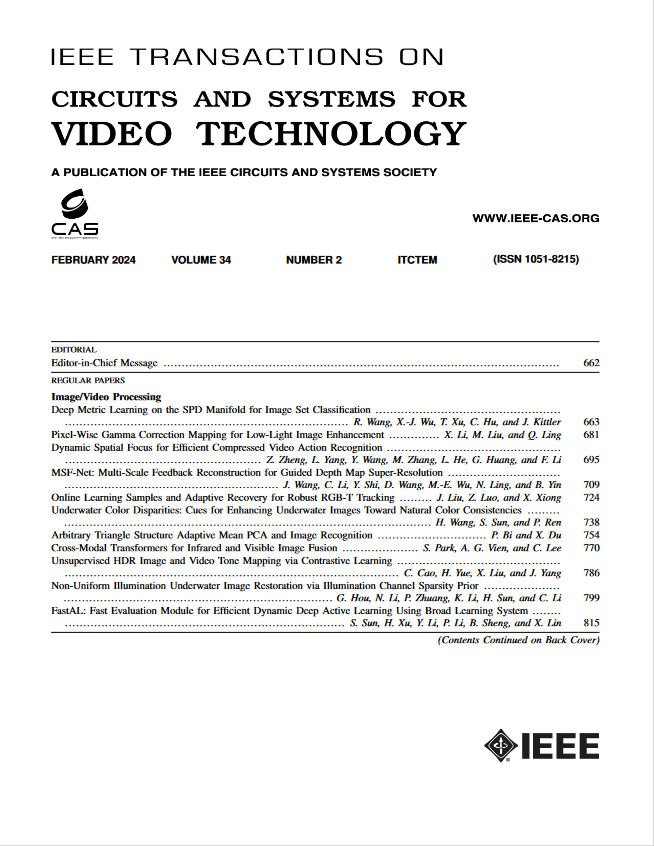When Aware Haze Density Meets Diffusion Model for Synthetic-to-Real Dehazing
IF 8.3
1区 工程技术
Q1 ENGINEERING, ELECTRICAL & ELECTRONIC
IEEE Transactions on Circuits and Systems for Video Technology
Pub Date : 2025-01-08
DOI:10.1109/TCSVT.2024.3520816
引用次数: 0
Abstract
Image dehazing is an important preliminary step for downstream vision tasks. Existing deep learning-based methods have limited generalization capabilities for real hazy images because they are trained on synthetic data and exhibit high domain-specific properties. This work proposes a new Diffusion Model for Synthetic-to-Real dehazing (DMSR) based on the haze-aware density. DMSR mainly comprises of a physics-based dehazing model and a Conditional Denoising Diffusion Model (CDDM)-based model. The coarse transmission map and coarse dehazing result estimated by the physics-based dehazing model serve as conditions for the subsequent CDDM-based model. In this process, the CDDM-based dehazing model progressively refines the coarse transmission map while generating the dehazing result, enabling the model to remove haze with accurate haze density information. Next, we propose a haze density-aware resampling strategy that incorporates the coarse dehazed result into the resampling process using the transmission map, thereby fully leveraging the diffusion model for heavy haze removal. Moreover, a new synthetic-to-real training strategy with the prior-based loss function and the memory loss function is applied to DMSR for improving generalization capabilities and narrowing the gap between the synthetic and real domains with low computational cost. Extensive experiments on various real datasets demonstrate the effectiveness and superiority of the proposed DMSR over state-of-the-art methods.感知雾霾密度满足扩散模型的合成到真实除雾
图像去雾是后续视觉任务的重要前置步骤。现有的基于深度学习的方法对真实模糊图像的泛化能力有限,因为它们是在合成数据上训练的,并且表现出高度的领域特异性。本文提出了一种基于雾感密度的合成到真实除雾(DMSR)扩散模型。DMSR主要包括基于物理的去雾模型和基于条件去噪扩散模型(CDDM)的模型。基于物理的去雾模型估计的粗透射图和粗去雾结果为后续基于cddm的模型提供了条件。在此过程中,基于cddm的除雾模型在生成除雾结果的同时,逐步细化粗透射图,使模型能够以准确的雾霾密度信息去除雾霾。接下来,我们提出了一种雾霾密度感知重采样策略,利用透射图将粗去雾结果纳入重采样过程,从而充分利用扩散模型去除重雾。此外,将基于先验的损失函数与记忆损失函数相结合的合成到真实训练策略应用于DMSR,提高了DMSR的泛化能力,缩小了合成域与真实域的差距,且计算成本较低。在各种真实数据集上进行的大量实验证明了所提出的DMSR优于最先进的方法的有效性和优越性。
本文章由计算机程序翻译,如有差异,请以英文原文为准。
求助全文
约1分钟内获得全文
求助全文
来源期刊
CiteScore
13.80
自引率
27.40%
发文量
660
审稿时长
5 months
期刊介绍:
The IEEE Transactions on Circuits and Systems for Video Technology (TCSVT) is dedicated to covering all aspects of video technologies from a circuits and systems perspective. We encourage submissions of general, theoretical, and application-oriented papers related to image and video acquisition, representation, presentation, and display. Additionally, we welcome contributions in areas such as processing, filtering, and transforms; analysis and synthesis; learning and understanding; compression, transmission, communication, and networking; as well as storage, retrieval, indexing, and search. Furthermore, papers focusing on hardware and software design and implementation are highly valued. Join us in advancing the field of video technology through innovative research and insights.

 求助内容:
求助内容: 应助结果提醒方式:
应助结果提醒方式:


